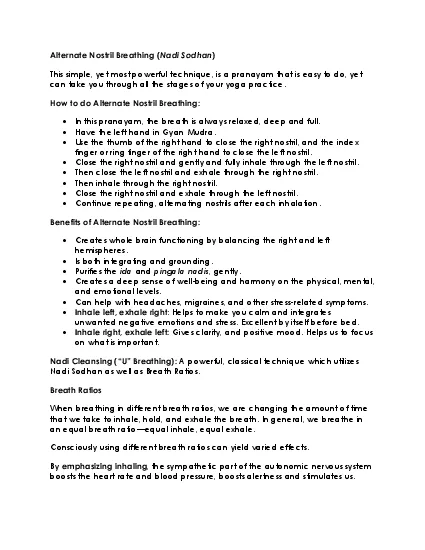

Nadi SodhanThis simple yet most powerful technique is a pranayamthat is easy to do yet can take you through all the stages of your yoga practiceHow to do Alternate Nostril BreathingIn this pranayam th ID: 860433
Download Pdf The PPT/PDF document "Alternate Nostril Breathing" is the property of its rightful owner. Permission is granted to download and print the materials on this web site for personal, non-commercial use only, and to display it on your personal computer provided you do not modify the materials and that you retain all copyright notices contained in the materials. By downloading content from our website, you accept the terms of this agreement.
1 Alternate Nostril Breathing ( N adi Sod
Alternate Nostril Breathing ( N adi Sodhan ) This simple, yet most powerful te chnique, is a pranayam that is easy to do, yet can take you thro ugh all the stages of your yoga practice. How to do A lternate Nostril Breathing: ï· In this pranayam, the breath i s always relaxed, deep and full. ï· Ha ve the left hand in Gyan Mudra. ï· Use the thumb of the right hand to close t he right nostril, and the index finger or ring finger of the right hand to close the left nostril. ï· Close the right nostril and gently and fully i nhale through the left nostril. ï· Then close the left nostril and ex hale through the right nostril. ï· Then in hale through the right nostril. ï· Close the right nostril and e xhale through the left nostril. ï· Continue repeating, alternating nostrils after each inhalation. Benefits of Alternate Nostril Breathing: ï· Creates whole brain functioning by balancing the right and left hemispheres. ï· Is both integra ting and grounding. ï· Purifies the ida and pingala nadis , gently. ï· Creates a deep sense of well - being and harmo ny on the physical, mental, and emotional levels. ï· Can help with headaches, migraines, and other stress - related symptoms. ï· Inhale left, exhale right : Helps to make y ou calm and integrates unwanted neg ative emotions and stress. Excellent by itself before bed. ï· Inhale right, exhale left: Gives clarity, and pos i tive mood. Helps us to focus on wha
2 t is important. Nadi Clea nsing (âUâ
t is important. Nadi Clea nsing (âUâ Breathing): A powerful, classical technique which utilizes Nadi Sodhan as we ll as Breath Ratios. Breath Ratios When breathing in different breath ratios, we are c hanging the amount of time that we take to inhale, hold, and exhale the breath. In general, we breathe in an equal breath ratio â equal inhal e, equal exhale. Consciously using different breath r atios can yield varied effects. By emphasizing inhaling , the sympathetic pa rt of the autonomic nervous sys tem boosts the heart rate and blood pressure, boosts alertness and stimulates us. By emphasi zing exhaling , the parasympa thetic nervous system slows the heartbeat and relaxes the circulation, nerves, and digestive system. It relaxes us and promotes elimination, b o th physically and emotionally. You can use mantra to measure the ratios. For examp le: 1:4:2 (Inhale I, hold 4, exhale 2 ). Thi s is used in the Nadi Cleansing pranayam. It is powe rfully purifying and cleansing. Left Right Nostril Breathing Through the simp le mechanism of closing or open ing one of the nost rils, the yogi has a wide array of techniques to control his moods and energies. The quality of Pra na processed through the two nostrils differs c orresponding ly with the qualities associated with the two sides of the brain. The nerves going out from the two brain hemispheres cross at the level of the eyebrows. The left hemi sphere is connecte d to the right side of the body and r
3 ight nostril , and t he right hemisph
ight nostril , and t he right hemisphere to the left sid e of the body and left nostril. We breathe predominant ly through one nostril or the other at a ny given time. The dominant nos tril alternates rhythm ically eve ry 90 to 150 minutes. The length of the cy cle reflects universal rhythms, individual tempera ment, and the personal state of mental and physical bal ance. The rhythm itself is mediated mainly through structures in the hypo thalamus and pitui tary, though other areas in the brain are also involved. You may use the technique of inhaling and exhal ing exclusively throu gh either the left or ri ght nos tril in order to bene fit from the quality associated with that nostril. Fo r instance, breathe exclusively through the left nost ril to deal with compulsive eat ing habits. Breath ing through the left nostril is associated with: ï· Ida, the nadi which ends at the left nostril ï· A pana, the cleansing energy ï· The Moon energy â cooling, receptive ï· Calmness ï· Empathy ï· Sensitivity ï· Synthesis Breathi ng through the right nostril is associated with: ï· Pingala, the nadi ending at the right nostr il ï· Prana, the nurturing energy ï· The S un energy â warming, projective ï· Vigor ï· Concentration ï· A lertness ï· Readiness - for - action ï· Will power Inhale Sat. Exhale Naam . © 2003 The Teachings of Yogi Bhajan, KRI International Teache r Training Manual Level I, p.